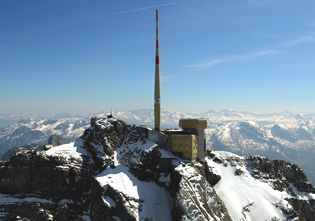
The Säntis Tower (Fig. 1) is a 124-meter tall tower sitting on the top of the 2502-m tall Mount Säntis located at 47°14’57”N and 9°20’32”E in the Appenzell region in the northeast of Switzerland. The grounding resistivity in the Säntis Mountain area (rocky soil) is in the order of 10 kΩm. The tower has a hollow, metallic inner conical structure 2m radius at the base and 1 m at its top. An outer Plexiglas structure has a radius of 3 m at the base and 1.5 m at the top. The structure serves mainly as a telecommunications tower and as a weather station. A decade-long analysis on the lightning incidence to several towers at various locations in Switzerland resulted in the choice of the Säntis tower, which is struck by lightning about one hundred times a year.

Fig.1. Säntis Tower
The Säntis station has been instrumented using advanced and modern equipment including remote monitoring and control capabilities for an accurate measurement of lightning current parameters. The lightning current is measured at two different heights, 24 m and 82 m. At the lower height, we installed two Rogowski coils with different sensitivities, each one with its analog integrator used to obtain the current waveform. These Rogowski sensors were manufactured, respectively, by PEM Inc. and ROCOIL. Two further sensors were installed at 82 m. The first one is a Rogowski coil (PEM Inc.) coupled with its analog integrator. The second sensor placed at that height is a specially-designed multi-gap magnetic loop (B-Dot) sensor. It has been specifically developed to measure the lightning current derivative [16]. The analog outputs of the sensors are relayed to a digitizing system by means of A/D – D/A 12-bit optical links characterized by an overall bandwidth from DC to 25 MHz. The maximum measurable current level with the PEM Rogowski coils is 120 kA and the maximum measurable current derivative with the B-Dot sensor is 400 kA/μs. The PEM Rogowski coil located at 82 m is characterized by a frequency response ranging from 50 mHz to 2.4 MHz, while the upper frequency limit of the B-Dot sensor is about 20 MHz. The measurement window for each flash is 1.2 s with a pre-trigger delay of 0.25 s and a sampling frequency of 100 MHz. Each flash is triggered by the B-dot sensor and the trigger level is 2 kA/μs.
The status and settings of each pair of sensors can be monitored and changed by means of a control system designed and built using National Instruments Compact-RIO modules linked via fiber optics using 100Base-FX Ethernet. A local server running monitoring and storage tasks is housed in a shielded control room several tens of meters from the base of the tower. The server and the front-end station are connected to the Internet over a router and a standard DSL link, allowing remote maintenance, monitoring and control of the overall measurement chain.
More details on the installed measurement system can be found in the following references:
C. Romero, M. Paolone, M. Rubinstein, F. Rachidi, A. Rubinstein, G. Diendorfer, W. Schulz, B. Daout, A. Kälin, P. Zweiacker, “A system for the measurements of lightning currents at the Säntis Tower“, Electric Power Systems Research, vol. 82, num. 1, p. 34-43, 2012.
C. Romero, A. Mediano, A. Rubinstein, F. Rachidi, M. Rubinstein, M. Paolone, P. Zweiacker, N. Mora, D. Pavanello, and B. Daout, “Measurement of Lightning Currents Using a Combination of Rogowski Coils and B-Dot Sensors“, Journal of Lightning Research, Vol. 4, No. 1, pp. 71-77, 2012.
C. Romero, F. Rachidi, M. Paolone, M. Rubinstein, “Statistical Distributions of Lightning Currents Associated with Upward-Negative Flashes Based on the Data Collected at the Säntis Tower in 2010 and 2011“, IEEE Transactions on Power Delivery, Vol. 28, No 3, pp. 1804-1812, 2013.